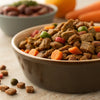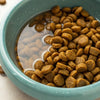How Long Will Dry Dog Food Last? Essential Tips for Pet Owners
- Houndsy
Table of Contents
- Introduction
- Understanding Shelf Life
- Factors Affecting Shelf Life
- Signs That Dog Food Has Gone Bad
- Best Practices for Storing Dry Dog Food
- Conclusion
Introduction
Did you know that dry dog food, also known as kibble, can have a shelf life of up to 18 months when unopened? However, once that bag is opened, it’s a different story. Pet owners often find themselves wondering, “How long will dry dog food last?” Understanding the shelf life of our furry friends' food is crucial not only for their health but also for our convenience as pet parents.
In this blog post, we’ll dive deep into the longevity of dry dog food, offering insights into how proper storage can extend its freshness and nutritional value. We’ll explore the factors that affect shelf life, signs that your dog's food may have gone bad, and best practices for keeping it fresh. By the end of this article, you’ll have a comprehensive understanding of how to store dry dog food effectively, ensuring that every meal is nutritious and safe for your beloved pet.
Let’s embark on this journey together and reflect on our own pet feeding routines—how can we make them more streamlined and enjoyable?
Understanding Shelf Life
What Is Shelf Life?
Shelf life refers to the period during which a product remains usable, consumable, or saleable. For dry dog food, this typically means the time it retains its flavor, texture, and nutritional quality. The lifespan is influenced by various factors, including the type of ingredients, packaging, and storage conditions.
Unopened vs. Opened Dry Dog Food
When it comes to dry dog food, the shelf life can vary significantly between unopened and opened bags:
- Unopened Dry Dog Food: Generally, unopened bags have a shelf life of 12 to 18 months. The “best by” or “use by” date printed on the bag indicates the manufacturer’s assurance of quality until that time, assuming optimal storage conditions.
- Opened Dry Dog Food: Once the bag is opened, the recommended usage period is typically 4 to 6 weeks. This shorter timeframe is due to increased exposure to air, moisture, and light, which can degrade the food's quality and lead to spoilage.
Nutritional Degradation Over Time
It’s important to note that while dry dog food doesn’t “expire” in the traditional sense, its nutritional value can diminish over time. Vitamins and minerals can degrade, meaning your dog may not be receiving the optimal nutrition if the food is stored for an extended period.
Factors Affecting Shelf Life
Storage Conditions
Proper storage is vital to prolonging the freshness of dry dog food. Here are key factors to consider:
- Temperature: Store dry dog food in a cool place, ideally below 80°F (27°C). High temperatures can accelerate spoilage.
- Humidity: Excess moisture can lead to mold growth, which is harmful to your dog. Always keep the food dry and store it in a moisture-free environment.
- Light Exposure: Sunlight can degrade the quality of the food. It’s best to keep kibble in a dark place, away from direct sunlight.
Packaging
The type of packaging significantly impacts the shelf life of dry dog food. Most manufacturers use food-grade materials that are designed to keep the food fresh. Here are some storage tips related to packaging:
- Original Packaging: Keeping the food in its original packaging is often recommended, as it is specifically designed to preserve freshness. Ensure the bag is tightly sealed after each use.
- Airtight Containers: If you prefer transferring your dog food to another container, choose an airtight, hard-sided container. This helps protect against pests and maintains the food's quality.
Quality of Ingredients
The type of ingredients used in the dog food can also affect its shelf life. Foods with higher fat content may spoil faster than those with lower fat levels. Always choose high-quality dog food from reputable brands, as they often have better preservation methods.
Signs That Dog Food Has Gone Bad
Visual and Olfactory Cues
Understanding how to tell if dog food has gone bad is essential for your pet's safety. Here are some common signs:
- Smell: If the dog food emits a rancid or unpleasant odor, it’s a clear indication that it’s no longer safe for consumption.
- Mold: Visible signs of mold or mildew are a definite sign that the food has spoiled. This can appear as blue, green, or white spots on the kibble.
- Texture Changes: If the kibble becomes moist, crumbly, or hard, it may have absorbed moisture and should not be fed to your dog.
Nutritional Quality
Even if there are no visible signs of spoilage, the nutritional content may still be compromised. If your dog is reluctant to eat their food or shows signs of lethargy or digestive issues, it may be time to evaluate the freshness of their kibble.
Best Practices for Storing Dry Dog Food
Optimal Storage Techniques
To ensure your dog’s food remains fresh and safe, follow these storage tips:
- Use Airtight Containers: Invest in a high-quality, airtight container to store your dog food. This will protect against pests and moisture.
- Keep It Cool and Dark: Store the container in a cool, dark place, away from heat and sunlight.
- Seal the Bag: If you keep the food in its original bag, ensure it’s tightly sealed after each use to minimize air exposure.
- Avoid Bulk Purchases: If your dog doesn’t consume large amounts of food quickly, avoid buying in bulk. Smaller bags will help ensure the food is used up while still fresh.
- Check Expiration Dates: Always be mindful of the expiration date and use the food before it reaches that point.
Using The Houndsy Kibble Dispenser
At Houndsy, we understand the importance of feeding your pet with fresh food. That’s why we designed the Houndsy Kibble Dispenser—a stylish and functional solution for storing and dispensing dry dog food. With its large storage capacity and ergonomic crank, you can easily dispense the right amount of kibble without the hassle of opening bags. Explore how our dispenser can elevate your pet feeding experience by visiting Houndsy Kibble Dispenser.
Conclusion
Maintaining the quality of dry dog food is crucial for your pet’s health and wellbeing. By understanding how long dry dog food lasts and employing effective storage techniques, we can ensure that our canine companions are always fed fresh and nutritious meals. Remember to keep an eye on expiration dates, observe for signs of spoilage, and invest in quality storage solutions like the Houndsy Kibble Dispenser to streamline your feeding routine.
As we reflect on our pet care practices, let’s strive to enhance their feeding experience while preserving their health and happiness. How do you currently store your dog food, and are there ways you could improve this process?
FAQ
Q: How long will dry dog food last once opened?
A: Once opened, dry dog food should ideally be consumed within 4 to 6 weeks to maintain its freshness and nutritional quality.
Q: Can I store dry dog food in the fridge or freezer?
A: While it is not recommended to store dry dog food in the fridge or freezer, keeping it in a cool, dark place is ideal. If you must freeze it, ensure it’s well-sealed to prevent moisture buildup.
Q: What should I do if my dog eats spoiled food?
A: If you suspect your dog has consumed spoiled food, monitor them closely for signs of food poisoning, such as vomiting or diarrhea. Contact your veterinarian if symptoms appear.
Q: How can I tell if my dog food is still good?
A: Check for any unusual smells, visible mold, or changes in texture. Additionally, ensure you are still within the recommended usage period after opening the bag.
Q: What type of container is best for dog food storage?
A: An airtight, hard-sided container is best for storing dry dog food. This helps to keep it fresh and free from pests. Be sure to wash and dry the container between uses.
By following these guidelines, we can ensure our dogs receive the best possible nutrition and enjoy their meals every day.












